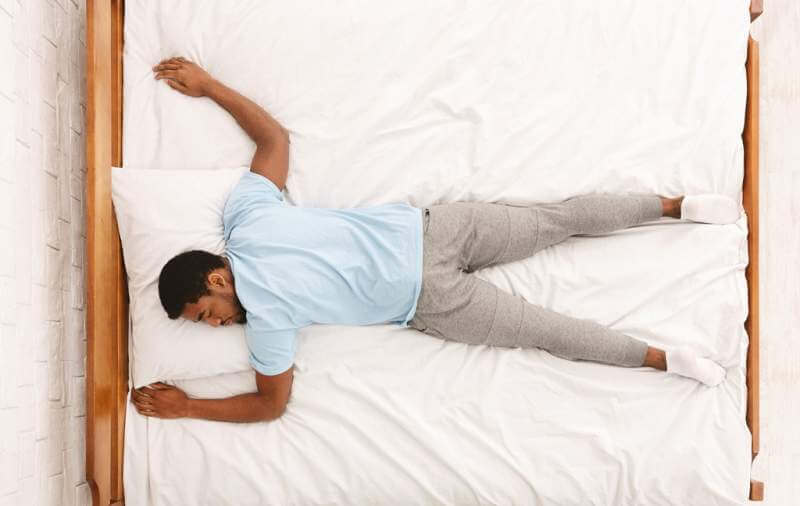It won’t be difficult to say that every 8 out of ten people among us must have complained about back pain at some point in life. The reasons for this may be countless, like an injury or an accident, a stiffed back muscle after being woken up or an imbalanced body posture.
Not many of us believe bad body posture as one of the crucial reasons for chronic or severe back pain but rest assure you will be amazed to know after you read on later how proper spinal positions and correct bone alignment can say goodbye to your stiffed back muscles.
Sleeping Positions
 Let’s begin with sleeping positions. You must have noticed a sore back muscle often after you wake up, this is because your cervical spinal was not in a good shape while you were asleep. For a better back posture, doctors suggest lying down on back or side position for better circulation and to avoid excess strain on the neck and back.
Let’s begin with sleeping positions. You must have noticed a sore back muscle often after you wake up, this is because your cervical spinal was not in a good shape while you were asleep. For a better back posture, doctors suggest lying down on back or side position for better circulation and to avoid excess strain on the neck and back.
So the first thing to avoid is to skip poor nightly postures such as curled up positions and sleeping over stomach which causes negative health impact later. Sometimes changing your pillow or using a flat pillow for neck support also works best in reducing the neck and back stiffness.
Sitting Positions
 Not many of us recognize that a bad sitting position can be the doorstep to a number of body defects, muscular and joint pains. Similar to the right sleeping position, a correct sitting posture will also help get rid of the spinal pain effectively. Whether you sit on a chair, bed or a sofa make sure your hip, back and neck bones are aligned into 90° angle.
Not many of us recognize that a bad sitting position can be the doorstep to a number of body defects, muscular and joint pains. Similar to the right sleeping position, a correct sitting posture will also help get rid of the spinal pain effectively. Whether you sit on a chair, bed or a sofa make sure your hip, back and neck bones are aligned into 90° angle.
Your hip bone is the base structures of your body while you sit, so rest assure you sit at a comfortable erect position without bending your backbone or neck forward. Pay a considerate amount of attention while you use your washroom, enjoy screen time or work at your office desk.
Forward Head Posture
 One of the leading reasons for back pain is poor head posture. From forwarding head posture to the frequent use of texting and laptops there are a number of reasons associated with back pains and postural misalignment. Treating this root cause will not only recover any sort of back pain but will also help in maintaining a good spinal structure. A good head posture is when your ears are at 90° to the shoulders, plus when your neck bone stands firm without leaning forward.
One of the leading reasons for back pain is poor head posture. From forwarding head posture to the frequent use of texting and laptops there are a number of reasons associated with back pains and postural misalignment. Treating this root cause will not only recover any sort of back pain but will also help in maintaining a good spinal structure. A good head posture is when your ears are at 90° to the shoulders, plus when your neck bone stands firm without leaning forward.
An incorrect forward head posture not only leads to chronic neck pain but also causes a high level of pressure on back & shoulders, improper breathing, and numbness in arms and hands. So if you experience any of these symptoms go through a forward head diagnosing wall test at home and reach the doctor or chiropractor for better consultation.
Miss Aligned Shoulder
 Carrying uneven weights, keeping shoulders stiff, high or forwardly bent can cause extreme stress on the neck & backbone. A typically bad shoulder posture not only stiffens the back of the neck muscles but also tightens the throat, back and chest muscles which in results cause the upper back to round forward and cause pain. This not only gives a dull body impression but also causes muscle aches and gets the skeleton out of alignment.
Carrying uneven weights, keeping shoulders stiff, high or forwardly bent can cause extreme stress on the neck & backbone. A typically bad shoulder posture not only stiffens the back of the neck muscles but also tightens the throat, back and chest muscles which in results cause the upper back to round forward and cause pain. This not only gives a dull body impression but also causes muscle aches and gets the skeleton out of alignment.
Whereas, keeping your shoulders relaxed and backward is the right posture to promote deep breathing, combat back and neck pain and a perfect way to get ideal body structure. Try shoulder release exercise to help free the rotator cuffs and feel the stress getting out of your neck. All you have to do is sit straight on a chair and bend your head forward to touch the skin of your neck and raise your shoulders upwards towards the ears. Hold steady but don’t forget to breathe and relax, repeat this for 5 to 10 minutes and you will see the magic happen.
Poor Standing Posture
 From the crown of your head to the heel of your feet every inch of your spinal structure determines the health of your body. Many times bad postural components are the underlying reasons for muscular and joint pains. Usually, the alarming situation of the neck pain triggers when the body’s muscles, tendons, and the spiral sequence is disturbed due to improper body balance.
From the crown of your head to the heel of your feet every inch of your spinal structure determines the health of your body. Many times bad postural components are the underlying reasons for muscular and joint pains. Usually, the alarming situation of the neck pain triggers when the body’s muscles, tendons, and the spiral sequence is disturbed due to improper body balance.
Starting from the hollow back, flat pelvis, slumping posture, military posture, round shoulders, high shoulder, high hip, head tilt, and severe scoliosis figure out which one of these is your improper standing posture. None of these is an ideal body posture apart from the 90 degrees body angle where your entire spinal structure is lined up into a straight line giving you a shapely and healthy body.
Bad Yoga Poses
 Sometimes even what we do with great intentions don’t give fruitful results, this implies to home-based yoga practitioners, who without having any sufficient knowledge about the yoga poses and body postures try to do it at home without any expert guidance. Remember exercises are a great way to treat the sore muscles and keep the body healthy and active but sometimes even the smallest imbalanced poses can cause severe distress to your sensitive body parts and can cause severe neck pain and back injury.
Sometimes even what we do with great intentions don’t give fruitful results, this implies to home-based yoga practitioners, who without having any sufficient knowledge about the yoga poses and body postures try to do it at home without any expert guidance. Remember exercises are a great way to treat the sore muscles and keep the body healthy and active but sometimes even the smallest imbalanced poses can cause severe distress to your sensitive body parts and can cause severe neck pain and back injury.
Every exercise is designed by keeping in mind several aspects such as age, body weight, gender, pain sensitivity, stamina, etc. so before taking into any action do consult a professional trainer first as to get better guidance about what exercise will suit you best, before you get yourself in some serious orthopedic problem.
Well, this is all about basic essential information about how postures affect the body in good and bad ways. Surely, a human body is a very complex system but just for the sake of keeping things simpler many doctors, massagers and chiropractors believe that a wrong spinal posture and displaced bones are one of the reasons for orthopedic pains and muscle stiffness. So the next time you complain about any such pain does consider which of your body posture does not fit well to the spinal alignment.
